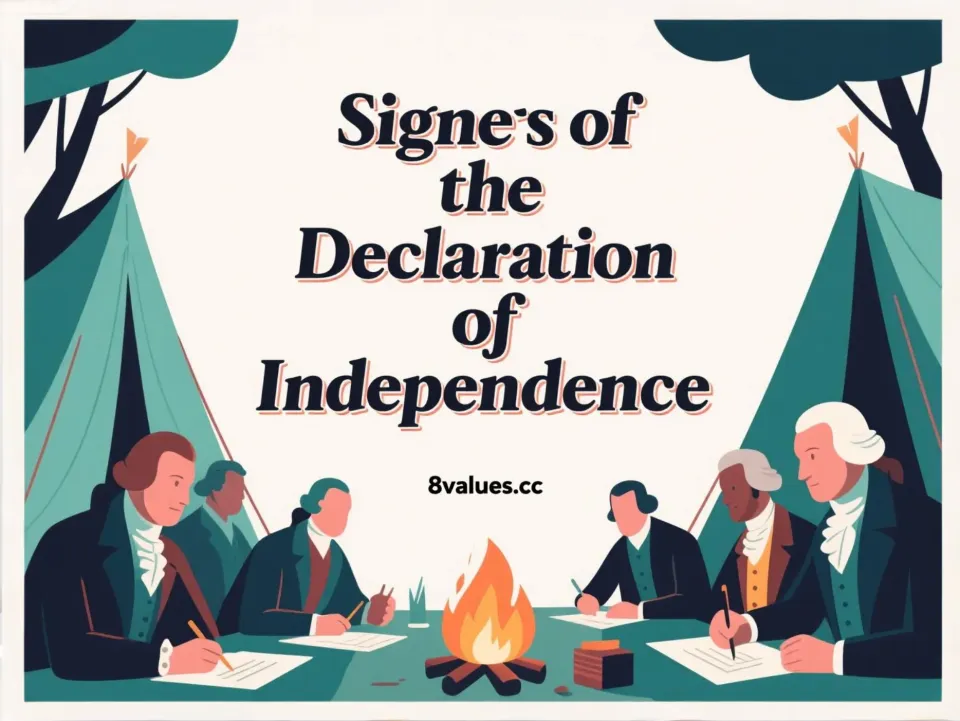Signatories of the Declaration of Independence: The courage and risks of 56 Founding Fathers
Take a deeper look at the background of the 56 signers of the Declaration of Independence and understand how they entrust their lives, property and honor to each other with the courage and risks of their lives, property and honor when signing the treason document, and the impact of this document on American political ideology.
In the summer of 1776, a grand political action that determined the fate of North American colonies was held in Philadelphia, and the core outcome of this action was the Declaration of Independence . This document is not only an official statement of the thirteen American colonies to cut off political ties from the Kingdom of Great Britain, but also a political philosophy declaration issued by a group of brave signatories to the world with their bets on life, wealth and sacred honor .
Signing the Declaration of Independence: A Declaration at the Price of Treason
In 1776, the declaration of independence was not easy, it legally constituted a treason against the British royal family, and if the revolution failed, the signatories of the Declaration of Independence would face severe risks of the death penalty.
From consultation to resolution: the difficult road to independence
The military conflict between the colonies and Britain has lasted for more than a year since the Battle of Lexington and Concord (Lexton gunfire) broke out in April 1775. Despite the flames of war, many colonists initially aimed at fighting for their rights as "British subjects" in the British Empire, rather than being completely independent. However, as King George III of England refused to reconcile and declared the colony to rebel, and also considered hiring foreign mercenaries to suppress the colony, the colony's fantasy of the king was completely shattered.
This transformation of social sentiment laid the foundation for formal publicity of independence. After the publication of Thomas Paine's Common Sense, the booklet of Thomas Paine's Common Sense, was published in January 1776, and it was unprecedentedly passionate to clearly argue that the colonies must break completely with Britain, establishing political independence .
On June 7, 1776, Virginia Representative Richard Henry Lee proposed the famous Lee Resolution at the Second Continental Congress :
"Resolution: These joint colonies are now, and should be, free and independent states; they release all obligations of allegiance to the British royal family and shall completely terminate all political ties with Great Britain."
The adoption of this resolution marks formal legal independence. Although many delegates were still concerned at the time, the resolution was finally adopted on July 2 (the New York delegation abstained at the time and did not authorize support until July 9).
Drafting of the Manifesto: Thomas Jefferson's Touch
During the discussion of the Lee resolution, the Continental Conference appointed a Committee of Five on June 11 to draft a public declaration to explain and prove the reasons for the colonies' seeking independence.
Members of the five-member committee include John Adams of Massachusetts, Benjamin Franklin of Pennsylvania, Thomas Jefferson of Virginia, Robert R. Livingston of New York, and Roger Sherman of Connecticut.
Although John Adams was the main voice in promoting independence, he insisted that it should be written by Thomas Jefferson on the grounds that Jefferson was a member of the Virginia delegation (with influence) and was far superior to his writing. Thomas Jefferson, who was only 33 years old, rented a house on the second floor of Philadelphia, completed the first draft between June 11 and 28, 1776. The idea of this declaration was deeply influenced by the theory of natural rights by the Enlightenment philosopher John Locke .
The famous preface to the Manifesto expounds the core political philosophy :
“We believe that these truths are self-evident: all are created equal, and the Creator gives them certain unalienable rights, including Life, Liberty and the pursuit of Happiness .”
The preamble further states that the legitimate power of the government comes from the "consent of the governed" and that the people have the right to change or abolish the government when it undermines these goals in order to establish new safeguards.
The final text of the Declaration of Independence was approved by the Continental Conference on 4 July 1776.
8Values Political Test reminds you: The Declaration of Independence describes a political system based on the "consent of the ruled" . If you want to understand your political values tendencies , especially your views on dimensions such as freedom, authority, equality and progress, you are welcome to participate in the 8values Political Value tendency test .
The collective commitment of 56 signatories: treason and courage
Although the Declaration of Independence was adopted on July 4 and immediately printed as Dunlap broadside for distribution, historians generally believe that the signatures of 56 signatories on parchment mainly occurred on August 2, 1776.
The solemnity and risk of signing the site
The signing process is full of solemnity and tension. Participants all knew that if the War for Independence failed, their signature would become direct evidence of being hanged by the British royal family on treason .
Benjamin Rush described a scene of "contemplative and solemn silence" in his recollection of the atmosphere at the signing on August 2, 1811. Everyone was named and signed with a serious expression. William Ellery once called the declaration a "Death Warrant", but he still signed his name firmly.
John Hancock , as President of the Continental Congress, is the first signator of the Declaration of Independence and has the most famous and heroic signature. Legend has it that after signing a huge name, he said: "The British cabinet can see this name without wearing glasses."
Heroic deeds: breaking the deadlock with actions
The experiences of some of the 56 signatories highlighted particularly the risks and courage they took to fight for independence:
- Caesar Rodney (Delaware) : At the critical moment of the Continental Conference vote on July 2, Rodney overcame the pain of asthma and facial cancer, rode 80 miles (about 128 kilometers) and rushed from Dover to the Independence Hall in Philadelphia overnight under thunderstorms. His timely arrival broke the deadlock of the Delaware delegation and cast a key vote in favor of independence. This is an action that demonstrates a sense of responsibility, courage and treason .
- Thomas Jefferson (Virginia) : As the main drafter of the Declaration of Independence, he regarded the Declaration of Independence as the embodiment of the supreme principle of the American Revolution. Jefferson was a follower of Enlightenment thought, but as the great slave owner of Virginia, his ideas were clearly inconsistent with the reality of slavery. He strongly condemned the slave trade and the responsibility of the British king in his first draft, but the passage was deleted to unite the South and the North (the North also participated in slave transportation).
- Roger Sherman (Connecticut) : He is the only signator to sign all four important American documents , namely the Declaration of Independence , the Articles of Confederation , the United States Constitution and the Continental Association . Sherman was born into a family of farmers and shoemakers and became a lawyer and state activist through self-taught.
- Charles Carroll (Maryland) : He is the only Catholic signator of the Declaration of Independence and one of the richest and most educated people in the colonies, and he is committed to promoting freedom, religious freedom and Maryland's position in the new country.
- Property and health paid for independence : Many signatories pay a huge personal price. Carter Braxton of Virginia sacrificed most of his property to support the cause of freedom in the United States. Thomas Lynch Jr. of South Carolina, the youngest of the signatories to die (30), was missing in a shipwreck while seeking medical treatment in 1779 due to deterioration in health.
The political background and ideology of 56 signatories
The Declaration of Independence was not completed by a small number of elites, but a collective political act of 56 signatories representing the Thirteen United Colonials . The political ideology of these signatories was rooted in the Enlightenment thought and the British liberal tradition of the time.
In the Declaration of Independence , the colonists believed that they, as British subjects, had the same rights as native British citizens, including the right to tax the representatives they chose. When the British Parliament and King George III refused to guarantee these rights, the colonists chose to revolution.
The purpose of the declaration is to establish a government that guarantees life, freedom and the right to pursue happiness , and its power must come from the consent of the ruled . This is the core principle of measuring democracy and sovereignty in the people in the modern political ideology test .
The declaration is mainly divided into five parts: introduction, preface, accusation of King George III, condemnation of the British people and conclusion. Among them, the accusation against the king accounts for the majority of the text, listing specific atrocities and overpowering acts in Britain that attempted to strengthen the management of the empire.
When signing the documents, the colonial representatives called on God (in the declaration, the Creator, the Supreme Referee of the World, and the God-Blessing) to show the justice of their intentions. This persistence in the political and moral foundation reflects their profound political philosophy beliefs.
The universal impact and lasting legacy of the Declaration of Independence
The Declaration of Independence not only united the colonial people and boosted morale of the War of Independence at that time, but was also a key diplomatic tool for the United States to win recognition and assistance from foreign countries, such as France.
Guidelines for political principles
Although the Declaration of Independence was once ignored by the American public and politicians in the decades after its birth, it did not regain its centrality until the 19th century Jeffersonian Republicans re-promoted its importance and Thomas Jefferson 's authorship in order to gain political advantage.
The core concept of the declaration— equal and inalienable rights —transcends its practical use of the initial declaration of independence and becomes the political and moral cornerstone of the United States that continues to this day.
This principle inspired social movements in later generations:
- Abolitionist Movement : Abolitionists such as Abraham Lincoln regarded the Declaration of Independence as the highest expression of the founding principles of the United States, believing that it sets the moral standards that the United States should strive to achieve. Lincoln insisted that the language of "everyone is born equal" is universal and applicable to all.
- Women's Rights Movement : The Declaration on the Rights of Women at the Seneca Falls Conference in 1848, in the format of the Declaration of Independence , declared that "all men and women are born equal."
- Civil Rights Movement : In his famous “I Have a Dream” speech in 1963, Dr. Martin Luther King Jr. cited the creed on equality in the Declaration of Independence , calling on the state to fulfill its commitment to all citizens.
The political legacy of 56 signatories
These signators promised each other that year: “We oath each other with our lives , our property and our divine honor .” This courage and determination make the Declaration of Independence a global template for political change and the pursuit of freedom. From the French Revolution to Haiti, Venezuela and even Czechoslovakia's Declaration of Independence, they have all been learned from or influenced by it.
By gaining insight into the background of the signatories of the Declaration of Independence , their political philosophy , and the huge risks they took when signing this "treason" document, we can better understand the political ideological pattern at the beginning of the founding of the United States.
If you are interested in conflicts and evolution between different political ideologies , or want to evaluate the position of your own political values in the global political map, we recommend that you explore the modern political spectrum using the 8values Political Values Prone Test .
Appendix: Archives and circulation of the Declaration of Independence
Currently, the official copy of the Declaration of Independence (parchment version) is permanently preserved in the National Archives Freedom Charter Exhibition Hall in Washington, DC.
The list of signers was not officially announced to the public for the first time until January 1777 after Mary Katherine Goddard printed the Goddard broadside . Until then, the signator's name was kept confidential for security reasons. This once again confirms the high personal risk of the 56 signatories at signing.
By the 1820s, due to severe fading of the original parchment documents, the U.S. government commissioned William J. Stone to produce a high-precision copper engraving copy (Stone engraving), which became the most commonly used version in modern times.






